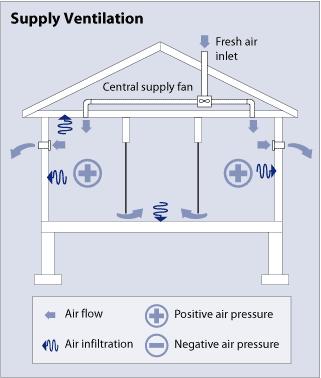Choosing a ventilation system
If you’re sick of stale air and weeping windows, but don’t know where to start, we’re here to help. Follow these steps, in conjunction with using our database, to narrow your options and find the best ventilation system for your home.
Sort out heating and insulation
You should only opt for a ventilation system if you’ve installed floor and ceiling insulation (if possible) as well as a decent heat source. In living areas this should be a fixed, efficient source of warmth, such as a heat pump or wood burner. In smaller rooms, portable plug-in electric heaters are sufficient.
Tackle moisture at the source
Identify any sources of airborne moisture, such as bathrooms, then consider installing a shower dome or extractor fan. Also look at fitting a plastic moisture control sheet to stop rising damp, and check if water is pooling under the home from any blocked drains.

Time for a dedicated ventilation system?
If problems persist, you can opt for a mechanical ventilation system, but note these cost upwards of $2000 (installed). A dehumidifier is a cheaper stopgap solution, but will cost more to run than a ventilation system.
Positive or balanced pressure?
The first thing to consider when looking at ventilation systems is whether you should go for positive pressure or balanced pressure – don’t confuse either with heat transfer systems.
Filters
Ventilation systems filter the air coming from your roof space or the outdoors. There are a wide array of filter types, usually designated by a letter and a number (for example, G4). In general, “F” filters remove smaller particles than “G” filters, so will catch more dust and airborne bacteria. The higher the second number, the more effective the filter – for example, an F7 filter will catch more nasties than an F6 filter. Some manufacturers offer optional advanced filters: carbon filters can be good for removing odours from the air (for example, the smell of everyone blasting their wood burner on a cold winter day), while HEPA filters are claimed to be effective at removing allergens. We recommend going for the standard filter initially, and only adding a carbon or HEPA filter if you find you’re dealing with odours indoors or suffering from allergies.
Optional heaters / summer cooling
Some systems offer the ability to add heaters to ducting, which can be useful for positive pressure systems if you’re concerned about cool air from the roof space reducing indoor temperatures. Summer cooling options, where the ventilation system introduces cooler air to the home, are available but can be expensive.
Controlling condensation
Winter condensation is a widespread problem. In winter we spend more time indoors, creating moisture from cooking, cleaning, washing and even breathing. When we're out of the house we leave it closed up for security.
Insulation adds to the problem. We trap the heat of living areas by keeping doors shut and using heavy curtains and carpets.
This all comes at a price. Warm air holds water better than cold air. Because it's sealed in, the moisture builds up then condenses on cold surfaces such as windows and walls.
The solution is simple – better ventilation. Making it happen is less simple.
If you're living in a draughty old Victorian villa, you shouldn't have too much of a problem with ventilation. But modern houses are much more airtight, so natural ventilation is minimal.
Extra heating is part of the solution, combined with water extraction near the sources. Rangehoods intercept steam from the kitchen; extractor fans are effective at drying out bathrooms. You could also consider a dehumidifier. While these can help control condensation, they’re expensive to run (up to $2.50 a day), often noisy, and must be run constantly. With a dehumidifier you are controlling the symptoms and not dealing with the problem. While not the ideal solution, dehumidifiers have their place.
An automatic ventilation system is a better way of controlling condensation. Whichever way you attack the problem, remember it's even more effective if the amount of water released into the air is reduced.
